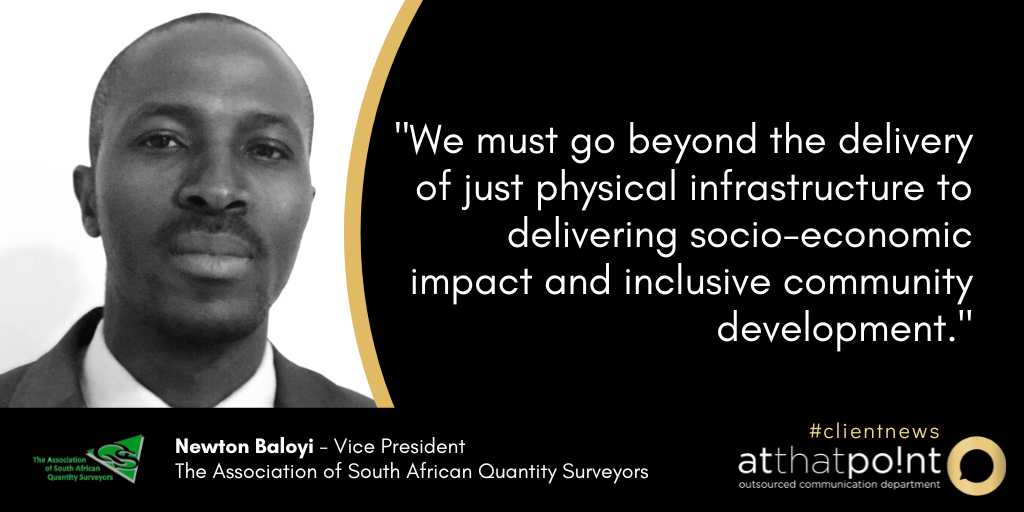|
“Infrastructure development is a catalyst for economic development but is often accompanied by strikes from communities, business forums and criminal activities by construction mafias. At the centre of this instability is the demand for meaningful participation by communities in the labour and business opportunities inherent in infrastructure projects,” said Newton Baloyi, Vice President of the Association of South African Quantity Surveyors (ASAQS) at the recent Western Cape Property Development Forum Conference held in Cape Town.
While the ASAQS welcomes the announcement of the establishment of the Broad-Based Black Economic Empowerment Advisory Council by President Cyril Ramaphosa, it however notes with concern that the panel seems not to have any representation from the built environment professions or construction sector procurement, despite the critical nature of infrastructure to South Africa’s economic recovery and development, and the high levels of instability and community disruptions on infrastructure projects. B-BBEE in the construction sector has specific unique challenges that need urgent attention. “The missing link is that our infrastructure procurement regulatory framework does not go far enough in addressing the socio-economic concerns of communities,” Baloyi said. “We need other mechanisms for measuring the performance of infrastructure projects. We must go beyond the delivery of just physical infrastructure to delivering socio-economic impact and inclusive community development.” Baloyi told the conference and supported his statement by sharing the findings of a pilot project he conducted. The pilot was based on a project set aside for the community. The findings showed that the benefit of the project to the community could be increased from 6 cents to 40 cents per Rand spent on the project and the payback period reduced from 17 years to 2.5 years. This meant that the benefit to the community could exceed the client’s procurement spent in just over 2.5 years. In addition, the social return on investment (SROI) would be improved from a negative 94% to a positive 60%. According to Baloyi, there are four interventions required to achieve these kinds of results for the construction sector. Firstly, a mindset shift to integrate impact measurement into construction projects. Secondly, integrate impact delivery into infrastructure procurement practices and legislation. Thirdly, establishing sector community capacity development programmes that enable meaningful community participation in projects rather than the current project-by-project approach. Lastly, proactive establishment of community buy-in based on the shared impact objectives of projects. “These four interventions must be coordinated and integrated into projects; having one without the other does not work,” Baloyi warned. The failure to integrate the four interventions is where B-BBEE fails communities and the construction sector. “Communities expect participation with or without capacity, otherwise there will be strikes,” said Baloyi “Yet, there are no sustainable capacity building programmes for community businesses and skills. The financial support needed by local businesses can hardly be accessed within the life of a project.” “These are systemic challenges that cannot be solved by social facilitators on construction projects, nor by a developer or contractor on a project-by-project basis. These challenges play a significant role in project delays, poor service delivery, budget overruns and delayed economic development. We hope that the B-BBEE advisory council will go a long way in addressing the fragmented approach to B-BBEE and foster the integration proposed herein.” “Given the high levels of poverty, inequality and especially youth unemployment and the negative economic outlook of South Africa, urgent interventions are required to avert intensified and violent strikes in the construction sector. Low hanging fruits include the establishment of an initiative led by the construction sector that integrates all stakeholders in the built environment to establish a voluntary pilot that can inspire hope in communities and reassure them that their concerns are being addressed.” “Rather than theorising about transformation, let’s do it in real-time and with real results as the built environment,” Baloyi told the conference as he called on developers, built environment professionals and contractors to amalgamate their skills development, supplier and enterprise development and SED/CSI resources to establish such a pilot linked to their portfolio of projects. He suggested that it is time for the built environment professionals to lead the transformation agenda in the construction sector. “We are the experts in infrastructure procurement and strategies and not government”. ENDS MEDIA CONTACT: Stephné du Toit, [email protected], 084 587 9933, www.atthatpoint.co.za For more information on ASAQS please visit: Website: www.asaqs.co.za LinkedIn: linkedin.com/company/asaqs Twitter: @the_ASAQS Facebook: facebook.com/asaqsza
0 Comments
 The quantity surveyor of today is far more than simply a “brick counter”. Their role is to keep a close eye on project finances and contractual relationships. “They make sure that the financial position of construction projects is accurately reported and controlled effectively,” Keith Skinner, President of the Association of South African Quantity Surveyors (ASAQS), said at the association’s recent Virtual Presidential Tour and Awards Ceremony. The profession is anything but stagnant and has been evolving at a rapid pace. Yet, the core principles have remained the same. “The quantity surveyor of today remains professional and unwavering in their approach to project governance,” he told ASAQS members during the virtual event. Referring to a Google search of the definition of a quantity surveyor who is described as a person who calculates the amount of material needed for building work, and how much it is going to cost, Skinner noted this may be the case of an average quantity surveyor in other countries, but certainly not locally. The True Role of Quantity Surveyors In South Africa the definition of a “construction cost consultant” or a “commercial manager” defines the role of our quantity surveyors far better in terms of the service they offer. “We are often associated with the construction or real estate sectors. However, we operate across different sectors. We have developed and delivered some of the best mining quantity surveyors in the world, and they find themselves in high demand.” He referred to the PwC annual mining report that highlighted the fact that the sector contributed 6.7% to South Africa’s Gross Domestic Product (GDP) last year and 7.6% this year. The sector created and sustained more than 1.6 million jobs last year and 2.3 million this year. “We have come from measuring brick walls to being involved in projects for a new mine shaft, a mine lift installation, or a new ship or units for Arctic expeditions. We should not just consider ourselves old fashioned brick counters.” Remaining Agile Larry Feinberg, executive director who has been with the ASAQS for ten years, said the association strives to maintain the highest professional standards, ensure ethical conduct and integrity in the profession; and to advance the common interest of the members. The key strategic objectives over the next three years are to ensure that the association remains agile and that it strengthens its brand and industry standing. “Over the past decade we have been flexing our muscles, weighing-in and having our professions voice heard, and taking “positions” on industry specific matters unapologetically when the situation demands this. Our association has also taken appropriate criticism over the last decade and responded with the necessary action or correction when required,” he added. EduTech has created a custom-made Continuous Professional Development (CPD) program which ensured that our members stayed on top of their game, despite Covid-19 restrictions. The program offered 20 webinars equating to 66 CPD hours. Members were able to take their pick from this “incredible value proposition” for a once-off fee of R750.00 compared to the average cost of over R400 per CPD hour in the preceding years, said Feinberg. Awards Karl Trusler, the association’s EduTech director, also announced the winners of the three annual awards that recognise the achievement of top quantity surveyor students.
Like many parts of the world, the South African built environment and construction industry is still in a slump. Economic pressure has led to a number of contractors relooking their pricing strategies to see how they can offer services at a lower price than their competitors. While this is a clever marketing strategy, it may expose clients to certain risks, says Henry van de Wall, member of the Association of Quantity Surveyors of South Africa (ASAQS), and Chairperson of its North West chapter.
“Some contractors may be able to absorb the cost of taking on projects that don’t necessarily yield a profit.” There are many ways that these contractors can lower their rates. A lower price could be offered if they are able to get material discounts from their suppliers, or if they are for example willing to cut their profit margins in certain areas. “While this can make good business sense in the current economic climate, it does open clients to certain risks,” warns Van de Wall. Clients being left with uncompleted buildings and legal costs One of the risks is that a contractor could be offering discounted rates to a number of clients and just scraping by or barely making a profit. If one or a number of his clients then defaults on payments, the contractor’s business may not be able to absorb the financial repercussions and be able to complete the work that he has committed to on other projects. In this case, a client’s building could be left uncompleted or the project could be delayed due to cash flow problems, or even worse – bankruptcy. “While hiring a professional Quantity Surveyor is often seen as something that only commercial clients should invest in, it is becoming more important than ever to obtain professional input regarding a contractor’s prices,” says Van de Wall. “This initial addition to the project costs will assist a great deal in protecting the larger investment.” Besides getting a market related estimate to confirm the tendered prices from a contractor, a Quantity Surveyor can also provide crucial clarity about the quality of materials and the scope of work that the client and contractor have agreed on. Avoiding unnecessary surprises in your Bill of Quantities Even with relatively straightforward building projects, the ASAQS has seen many disputes arising from contractors who are trying to bill for ‘extra work’ on building items that any client would rightfully deem to be included as a compulsory part of a building project. “A Quantity Surveyor can give clients the estimate, Bill of Quantities and professional guidance they need to protect themselves,” says Van de Wall. Quantity Surveyors aren’t only appointed to protect clients. Many contractors are also creating allowances for Quantity Surveying services in their own projects, which is the responsible way to proceed with building projects. Contractors are able to negotiate with Quantity Surveyors regarding fees so that they can still offer competitive rates to clients. The contractors then receive the benefit of being able to offer this professional estimation as a perk to clients, so it’s a win-win for all the parties who are involved in a project. “With this attitude, a Quality Surveyor isn’t seen as a referee, but rather an independent consultant and enabler who can provide the quality checks that both contractors and clients need to rest assured they are getting a valuable, financially suitable and sustainable building,” concludes Van de Wall. ENDS MEDIA CONTACT: Juanita Vorster, 079 523 8374, [email protected], www.atthatpoint.co.za For more information on ASAQS please visit: Website: www.asaqs.co.za Facebook: The Association of South African Quantity Surveyors Reports of construction sector confidence plummeting to 17-year lows should not be the reason for investors and developers to lose complete faith in the industry, according to the Building and Property Economics Committee of the Association of South African Quantity Surveyors (ASAQS).
“Low confidence in the construction sector is cause for concern due to the impact on investment and risk,” says James Hanley, chairman of the Committee. “The built environment is however known for being cyclical, and these cycles last approximately three years.” While sensible business planning and building up reserves in their practices is the standard recommendation during times of high confidence and investment, built environment professionals tend to be at the mercy of the market. What is needed to smooth out the cycles is better governmental planning and longer term infrastructure commitments that enable the sector to respond and build capacity. “If the past is anything to go by, the industry will start to improve soon,” says Hanley. “The construction industry normally lags the general industry by about 6 months, so improving conditions in the general economy tend to influence the cycle accordingly.” It is however unwise for business to only wait for macro-economic and –political factors to turn favaourable rather than doing what it can to ensure future sustainability. The Committee cautions against panic to reports of economic downturn and low investor confidence, and instead advises built environment professionals to make use of any surplus time they might have available to develop and broaden their skills. While it might seem counterproductive to seemingly take time away from business development to strengthen or diversify the professional skill set, the focus should be on the long term sustainability of the professional team. “By strengthening and diversifying their skills sets, built environment professionals will be better equipped to deal with disruptive changes that continue to challenge a variety of sectors,” says Hanley. The Committee also warns agains aggressive fee discounting that adds additional pressure to professionals such as quantity surveyors. This practice not only threatens the livelihood of individuals, but undercuts the reputation of an entire sector as a severe reduction in fees can easily create a perception that is disproportionate to the real value of a service. “Fee discounting is at best a poor business decision, and at worst anti-competitive,” warns Hanley. “Professionals that portray low confidence in their own skills through a willingness to undercut standard industry fees are doing more damage to the sector than macro-environmental factors.” Rather than reduce their fees to secure a sliver of a small pie, built environment professionals should rather increase their capability to showcase the value of their services. “It will serve both professional and sector interests – by increasing the amount of work available to all – if built environment professionals are capable of creating an understanding among clients of the true short term savings and lifecycle value of incorporating professional fees in the budget of any infrastructure development or maintenance project.” ENDS MEDIA CONTACT: Juanita Vorster, 079 523 8374, [email protected], www.atthatpoint.co.za For more information on ASAQS please visit: Website: www.asaqs.co.za Facebook: The Association of South African Quantity Surveyors ASAQS is committed to transformation and skills development in the built environmentThe built environment is one of many industries that faces challenges due to the skills crises. Exacerbating the issue locally is a lack of transformation, retiring baby boomers, too few formalised training and apprenticeship programmes as well as a lack of funds to support minority groups who are studying towards qualifications within the industry. Larry Feinberg, Executive Director at the Association of South African Quantity Surveyors (ASAQS), says that industry bodies such as ASAQS have a key role to play in promoting growth and transformation in the industry. “Besides the initiatives that have been launched by the private sector and government, industry associations are the stakeholders who can take action on a grassroot level to help alleviate skills development and transformation problems that are being faced within their sectors,” says Feinberg. One way that ASAQS is helping to make a difference is by launching a programme that supports quantity surveying students in achieving the necessary qualifications to become registered professionals. “Training in the built environment sector is important because it continues to provide the critical skills needed to design, construct, operate and maintain ever-increasing public and private infrastructure,” says Feinberg. Cities around the world are being are becoming highly populated and often, over burdened by the trend towards urbanization. People are continually gravitating in huge numbers towards the cities and towns to find economic opportunities and in the process the capacity of current infrastructure is being tested on all fronts. Critical skills are increasingly required to provide and maintain new infrastructure such as roads, essential service and buildings, to name but a few. “To meet this need, we require quality educational opportunities focused on the built environment which produces capacitated clients, professional quantity surveyors, engineers, project managers and skilled contractors and artisans,” Feinberg continues. “Clearly, the growing demand for infrastructure fuelled by urbanization calls for more, not less education and training in the built environment sector. We should recognise this trend and then make every effort to match up to it.” Feinberg expects the quantity surveying profession, along with other sectors within the construction and built environment, to be supported in their skills development and transformation endeavours through the 1.5 billion Tirisano Fund, which forms part of the Voluntary Rebuild Programme (VRP) Agreement between government and seven companies found guilty of collusion during the construction of stadiums for the 2010 Fifa World Cup. The fund is focused on providing support to black students studying engineering, quantity surveying and building science, among other disciplines, and could potentially play a vital role in stimulating transformation and growth. “ASAQS fully supports this initiative and is excited to be able to offer a training programme that can help students thrive in the built environment and graduate to become qualified quantity surveyors,” concludes Feinberg. ENDS MEDIA CONTACT: Cathlen Fourie, 082 222 9198, [email protected], www.atthatpoint.co.za For more information on ASAQS please visit: Website: http://www.asaqs.co.za/ Facebook: The Association of South African Quantity Surveyors Enthusiasts are seeing improvements in software as a sign that the days of the quantity surveyor are numbered. Nothing could be further from the truth. By Larry Feinberg, Executive Director, Association for South African Quantity Surveyors  Software has disrupted many industry sectors, from travel to insurance, and from retail to real estate. In each case, we were informed excitedly that the new technology would side-line humans. And yet estate agents, insurance brokers and even brick-and-mortar retail stores all still continue to grow. More accurately, those that have embraced the new technology have gone on to flourish. When it comes to quantity surveying we are seeing something like the same dynamic unfolding. An added element is that the profession is poorly understood by other players in the public and private sectors. Too often, quantity surveyors are seen simply as providers of Bills of Quantities and drafters of tender documents. In reality, a quantity surveyor has a much broader and more valuable role to play, especially in these days of mega-projects, strict regulation and, of course, unremitting cost pressure. It is true that intelligent software can help automate and improve some of the more routine elements of the quantity surveyor’s job, such as measurement and the collation of documents. But to see the role of the software in this light only, or even to see it to some extent replacing a quantity surveyor, is to miss the point entirely. Rather, the software should be seen as providing quantity surveyors with the space to provide the services that have, over time, come to define their real contribution to any project. This contribution includes the ability to determine the viability of a project from the outset, or to see the project holistically, in order to assist the owner to balance the architect’s vision with the realities of meeting cost targets that will ensure that planned returns are realized. This contribution continues, not only during the actual construction phase but throughout the entire life cycle of the building. I always think of the quantity surveyor’s role as one of creating a value proposition that extends from the design phase, through the construction phase and then ultimately throughout the life of the building management phase. Software alone, would be hard pressed to provide all these vital service solutions to clients. In addition, the quantity surveyor is able to take the basic data and calculations produced by the software as the basis for exercising his or her judgement—not, as many would have one believe, to bypass it. Software cannot take into consideration many of the long-term questions that are of increasing importance to those who fund large projects, and those who will use them. For example, what are the benefits of spending more during the construction phase in order to reduce costs over the life of the project? How can certain needs such as air conditioning be met in a way that it is environmentally responsible without compromising operational efficiency—or commercial viability? These, and similar questions, need the expert judgement of an experienced professional to resolve, not the wired-in certainties of a piece of software. By fulfilling this role, the quantity surveyor protects the interests of the client, including those who will use the finished product, and the broader community at large. ENDS MEDIA CONTACT: Cathlen Fourie, 082 222 9198, [email protected], www.atthatpoint.co.za For more information on ASAQS please visit: Website: http://www.asaqs.co.za/ Facebook: The Association of South African Quantity Surveyors by |
Archives
July 2024
Categories
All
|






 RSS Feed
RSS Feed